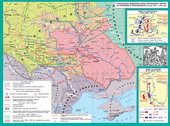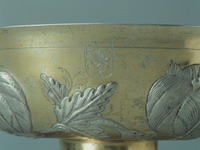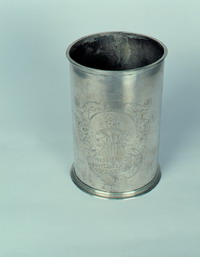UKRAINIAN-Moscow Treaty in 1654 CONTINUED National War
Principal PROCEEDINGS
- Ukrainian-Moscow Agreement of 1654 - an equitable agreement between two independent states.
- Bogdan Khmelnitsky - a prominent politician, founder of the Ukrainian Cossack state.
- Bogdan Khmelnitsky - far-sighted politician, a skillful diplomat, an experienced military leader, whose activities are not only determined the fate of Ukraine, but also significantly influenced the European political life, has changed its development.
CHRONOLOGY OF EVENTS
|
1654 March |
Conclusion Cossack mission agreement with the Moscow government. The March article. |
|
1655, January |
Ohmativska battle. |
|
1655, July |
Home Swedish-Polish war. Military action in Pomerania. Fall of Warsaw (August 29) . |
|
1655, September |
Battle of Gorodok. The siege of the city. |
|
1656, October |
Conclusion Union Transylvanian Prince George (Dyerdyem) II R |
|
1656, October |
signed between Moscow and the Commonwealth `s truce in Vilnius. |
|
1656, November |
Conclusion anti-Polish alliance between Swedish kingdom and the Transylvanian Principality. |
|
1656-1658 he |
Moscow-Swedish war. |
|
1657, January-July |
military operations troops Transylvanian Prince George (Dyerdya) II R |
|
1657, July 27 |
death of Hetman Bohdan Khmelnytsky. |
FIGURES
Zhdanovich Antin - Ukrainian military leader, diplomat. In 1649 he became colonel of Kiev. 1651 participated in the defense of Kyiv from the Lithuanian army. We perform the diplomatic mission to Turkey, Poland, Muscovy. 1656-1657 he commanded the army sent to help Khmelnytskyi Transylvanian Prince George (Dyerdyu) II R
Karl X Gustav - King of Sweden in the 1654-1660 biennium Khmelnytskyi saw in it a possible ally in the struggle with Poland. In October 1654 the Ukrainian diplomats held talks. They raised the issue of anti-Polish coalition, which should have included Ukraine, Sweden, Transylvania, Moldavia and Wallachia. In 1655 Karl-Gustav started the war against Poland. At the same claims found in western Ukraine. Subsequently agreed to include in future Galicia and Volhynia to the Hetman. After the death of B. Khmelnytsky in October 1657 was awarded the Ukrainian-Swedish military alliance.
NOTE!
Pereiaslavs'ka Council 1654 does not represent a majority view of the Ukrainian population (it generally attended by about 200 people), the same oath and Alex King (the king, and not Russia or Russian people!) was given a small population Hetman, often out of fear of reprisals or intentional violation of the oath formula. It is worth remembering that while the referendum was that of participation even in the discussion of these problems were alienated the peasantry, which constituted the majority population. (Of course, at that time in solving these problems have not participated and women). Orthodox clergy refused to swear as well as the Zaporizhzhya Sich. Hence, only part of the population Hetman (Cossacks with the gentry and townsfolk), and not all gave the oath. We know that from participation in the oath avoided several regiments, prominent figures of the National Liberation War (I. Bogun, J. deaf, G. Gulyanitskii, I. Sirko et al.). It should be noted that the oath and geographically covered only Naddniprianshchyna.
text of the treaty in 1654 in the usual for a modern diplomatic practice never existed. Specifics of the contract was that it concluded the three (not all!) States, each separately. Ukrainian Orthodox clergy refused after concluding a contract; commoners satisfied confirmation of their rights and liberties granted by Polish kings and Grand Dukes of Lithuania, and in so-called Articles of March, concluded its own Cossack delegation agreement was reached to 17 articles (of 23). Of the six important part of the parties have not reached consensus, several important aspects of Ukrainian-Russian relations were not reflected in the contract in 1654 historians generally agree that the agreement was incomplete and imperfect, but equal and mutually beneficial. Acted, however, it is a very short time and already in 1656, he was rudely interrupted by Moscow (Vilna truce). Because of this, the Ukrainian government made a military alliance with Sweden and Transylvania in 1656, and in 1658 signing Hadiach Covenant finally broke the Ukrainian-Russian agreement in 1654 was later launched the Russian-Ukrainian war 1658-1659 biennium, which lost to Ukraine and its government was forced to sign a contract Pereyaslavs'kyi 1659, this time is unequal, which ended the state of independence. (YA Mytsyk).
UKRAINIAN RELATIONS BETWEEN STATE AND Muscovy
- from the end of 1648 between the Hetmanate and Moscow State began a constant exchange of embassies.
- Hetman government concerned about the possibility of establishing relations with the Commonwealth of Muscovy. After all, they pinned Polyanivskyy peace treaty in 1634 that the king did not dare to violate in order not to give the Polish government over a new war.
- same time in Moscow was ready to assist the Commonwealth, there was no transfer of large military formations in Moscow-Ukrainian border. Moscow waited until both sides of the Ukrainian-Polish War znesylyatsya and beware of the flame Cossack rebellion that could spill over to Moscow lands.
- To push the government to the royal union with Zaporozhian Host, inc in June 1653 made it clear to the king: if he continues zvolikatyme to solve the Ukrainian issue, then Ukraine will enter into a union with Turkey. In addition, Hetman said the very unpleasant consequences of such a union for Muscovy.
- October 1, 1653 Moscow Zemsky Sobor decided: "... Bohdan Khmelnytsky and all the host cities and Zaporozhian to take land" and go to war against Poland. In connection with the decision of the Provincial council to Ukraine was assigned a large embassy, led by boyar Vasily Buturlin. Meeting and negotiating, awarding diplomas and imperial Kleynods held in the council in Pereiaslav January 8, 1654
-Moscow Ukrainian interstate agreement in 1654
- Pereiaslavs'ka council only started processing tit-Ukrainian relations, because no written agreements concluded in Pereyaslav was not. All negotiations should decide.
As a researcher discovered - day Cossacks Mytsyk, feature-Ukrainian Treaty of Moscow was that he was the group of documents from each of the states - though specific arrangements of the clergy, burghers, Cossacks.
- Cossack agreement consisted of 23 articles on behalf of the Hetman and Zaporizhia Army. The basic idea of these articles - the establishment of such inter-state relations under which Ukraine will remain both internally and externally independent. It is for these sexes Ukrainian embassy arrived in Moscow. The draft Ukrainian ambassadors gave the Moscow government March 14, 1654
Due week of negotiations the draft treaty with the Cossacks have changed somewhat agreed on 17 articles and six very important agreement was postponed to a later date. According to March sexes (so-called coordinated 17 articles):
- Getman officers and Cossacks were to elect the council.
- Ukrainian court administration and remained independent and not subordinate to Moscow.
- tax collection relied on Ukrainian military treasure.
- Number Cossack army was installed in 60 million people.
- Ukrainian citizenship had to keep all their rights and liberties that they had more data and Lithuanian princes, Polish kings, especially city government.
- lengthy negotiations Orthodox clergy had no results. Ukrainian Orthodox Church does not hold on the dependence of the Patriarch of Moscow, Moscow sought by government and the Russian Orthodox Church.
- Thus, only commoners generally come to an agreement with the Moscow government, together with the Ukrainian Cossacks Orthodox nobles - only partially, and Orthodox clergy abandoned the illegal demands of Moscow.
documents signed during the Ukrainian-Moscow negotiations of 1654, established the interstate relations that do not restrict the independence of Ukraine. Terms -Ukrainian Treaty of Moscow in 1654 testify to the unification of Ukraine and Muscovy in fact a kind of confederation agreement between the two countries was generally equal and (subject) mutually beneficial. At the same time it was incomplete and flawed, worked a short time (several years) and soon it violated his Russian side actually expired.
Value-Ukrainian Treaty of Moscow in 1654
- Despite imperfections and brevity, the Ukrainian-Moscow Treaty in 1654 during the XVII - XVIII century. regarded as the most convincing proof of Ukrainian sovereignty of Ukraine.
- gave independence to fully retain the newly established Ukrainian Hetman state.
- Ukrainian government was able to bring the war to the finish against the Commonwealth, and thus complete the reunification of all Ukrainian lands under his power.
- In international affairs, treaty reaffirmed Ukraine's right to separate from Poland.
- agreement was a sign of international recognition of independence of the Ukrainian state, the inviolability of the established system of socio-economic relations.
course of military action against Poland in the years 1654-1655
Soon - in Belarus and Smolensk opened hostilities. The West's military campaign by the tsar and sent to Bogdan Khmelnitsky 20000th army of Cossacks led by Colonel Nizhyn John Zolotarenko.
- To Moscow-allied Ukrainian troops that march was a success. In the summer of 1655 they broke the Lithuanian army was from Belarus and Lithuania took part along with the capital Vilnius.
- fall of 1654 and began military operations in Ukraine. In mid-November 30000th Polish Army on vderlasya Bratslavshchina. Trip lasted until the spring of 1655 was the result of his devastation skirts: mid-February was destroyed almost 50 cities.
- In December 1654 the Polish army combined with 30000th Tatar horde, January 15, treated the Uman and surrounded it. In support of John Bohun, who led the defense Uman went Cossack units Khmelnytsky and 10-12000th Muscovite army. This made the Polish-Tatar command to lift the siege and to return the army to meet the Ukrainian-Moscow forces.
- January 19, 1655 Polish-Tatar army surrounded the Ukrainian-Moscow camp in the village Ohmatovym (now in Cherkasy region.). The siege lasted several days and exhausted rivals. Particularly plagued frost. Contemporaries called the battle "field shakiness, or Dryzhypolem, and the battle of Ohmatovym - Dryzhypilskoyu battle.
- Ohmativska battle ended with a slight advantage of the Ukrainian army, but Bogdan Khmelnitsky failed to inflict a decisive blow Polish-Tatar army and liberate her from the territory Bratslavshchina.
- spring of 1655 Khmelnytsky went through the skirts of the army in Galicia. The aim of the campaign was free from Polish domination in western lands and unite Ukraine in its ethnic borders. In early August, the army stopped near Kamenets-Podolsky.
- During the siege of Hetman received the Swedish ambassador. He reported on July 9 join Sweden in the war against Poland. Inc, for its part, promised military assistance to the Swedish king.
- September 19, 1655 Ukrainian army utterly defeated the Polish army crown hetman Stanislaw Potocki under Gorodok , which 25 km from the city. As a result of that victory was released much of western Ukraine.
- the same day the Ukrainian army approached the city and surrounded it. Realizing that the storm will cause heavy losses not only locals but also the army, Bogdan Khmelnitsky agreed to talks with Lviv authorities. Soon Hetman received ransom and retreated from the city.
- After the Battle of Lake town November 12, 1655 agreement was concluded between the hetman and the Crimean khan. It included non-interference in Crimea, Ukraine and Moscow's war against Poland. The contract gave the opportunity to avoid the Tatar attacks on Moscow and the Ukrainian land.
Thus, despite the complexity of the situation, the summer-autumn campaign in 1655 for the Ukrainian-Moscow forces in Ukraine succeeds.
Vilna Muscovite-Polish armistice in 1656
- late 1655th the first half of 1656 Khmelnytsky led a very active diplomatic activities: exchanged embassies with Swedish and Polish kings, the Crimean Khan, the owner of the Moldavian and Transylvanian prince.
- However, the government of Tsar Alexis, scared by the success of Swedish troops in combat in Poland (Sweden captured almost all of Poland), began actively preparing for war against Sweden.
- Polish diplomats, seeking to save the motherland, and offered the Polish crown upon the death of Jan II Casimir Alex. The proposal also urged talks with Moscow to Warsaw, which ended October 24, 1656 Vilensky truce.
Behind him - hostilities between Moscow and the Commonwealth ceased;
- both countries are committed not to start peace negotiations with Sweden;
- instead envisaged joint military operations against Sweden and Brandenburg;
- elected king of the Polish throne.
Ukrainian delegation to participate in negotiations Vilensky Moscow diplomats prevented, and offers Khmelnitskogo the position of negotiating ignored, which was enraged by the Cossacks and the hetman.
CHANGE foreign policy of Bogdan Khmelnitsky
- Vilna Muscovite-Polish armistice in the Hetman's capital was perceived as a flagrant violation of the treaty of 1654, actually, as a betrayal of the king. Getman decided to seek new allies against Poland.
- real contenders were Transylvania and Sweden.
- Relations Transylvania inc established in 1648 has, however, they were not equal: that Allied, then strained, as happened after the unsuccessful raid Timosha Khmelnytsky in Moldova in autumn 1653 he
- October 8, 1656 Host Zaporozhian between Transylvania and an agreement on military alliance with the Commonwealth.
- Transylvanian Prince George (Dyerd) II R
- diplomatic relations with Sweden Bohdan Khmelnytsky began in 1652 and supported in the future. Already in September 1655 when the outbreak of the Polish-Swedish war, inc offered Karl-Gustaf alliance against Poland on condition that all the Ruthenian (Ukrainian) lands of the Commonwealth will be given to Ukraine.
- In 1656 Ukraine relations with Sweden were scheduled, but the Swedes did not want to give Ukrainian lands were under Poland, because most of them claimed.
- In January 1657 Swedish ambassadors brought draft treaties of alliance, but only with the recognition of the state of the Cossack territories (Dnieper). Inc refused the contract.
In June - Chyhyryn newly arrived Swedish embassy. It is reported that King Carl Gustaf agrees to pay the hetman of the Ukrainian lands under Polish, part of Belarus and Smolensk, it leaves a land of Poland.
- In December 1656 George (Dyerd) II R
OF UKRAINIAN troops in Galicia and Poland in 1656-1657 he
- When December 1656 began offensive Transylvanian Prince George (Dyerdya) II R
- At first Swedish-Ukrainian-Transylvanian army operated successfully: gaining Przemysl, Warsaw, Krakow, Lublin, Brest.
- However, mid-May his situation worsened. Failures repeatedly persecuted allies.
Through - attack of Denmark to Sweden Swedish king left George Rakoczy.
- strained relations became prince with the Cossacks.
- learning about the invasion of Polish troops to Transylvania, George Rakoczy, despite the fact that Warsaw was taken, began negotiations with the Poles.
- 11-12 July 1657, having received news of the approaching Tartar invasion, which could cut his way back and finally losing hope for the successful conclusion of the struggle against Poland, the Transylvanian prince surrendered.
- Cossacks learned about the intentions on the eve of George Rakoczy and surrender, fearing that he will give them Poles away from him.
Bogdan Khmelnitsky - politicians, diplomats, military leader
march against Poland brought the final victory over the Commonwealth. When news of the unauthorized Zhdanovicha return to Ukraine came to the hetman, this caused him a fatal blow. July 27, 1657 Ukrainian hetman died.
- determining where to Bohdan Khmelnytsky in Ukrainian history, the researchers emphasize that his main achievements was the revival of the Ukrainian state. It is in the restoration of an independent state which would unite all ethnic Ukrainian lands and would be heir of Kievan Rus , saw the results led him Hetman National War of Independence. So expansion state of all its branches occurred under his personal supervision.
- concentrated in the hands of the hetman of the legislative, executive and judicial authority. He, in particular:
- called General and the officer council;
- was chief of the armed forces;
- issued proclamations;
- involved in legal proceedings (acting hetman of general military court);
- charge of finance;
- by the Board started the war;
- led peace talks;
- led diplomatic relations with other states and intelligence services.
Bogdan Khmelnitsky - efforts during the first year of war with scattered peasant and Cossack units created one of the strongest armies in Europe at that time. People's Liberation Army consisted of over 100 thousand Cossacks and was organized by regiment centesimal-territorial principle: a certain area exhibited several hundred Cossacks, which joined the regiment.
- Bogdan Khmelnitsky attracted to the Cossack Army of highly commanders. They came from different social conditions, but all united extraordinary commitment to the National Liberation War and personally Brussels. Hetman closest entourage were Philo Jalali, Theodore Veshnyak John poise, Nestorenko Maxim, Maxim Sergeant, Tymish proboscis monkey, take Vyhovski, Nechai, Zolotarenko, Gulyanitskii, S. Krichevsky, Michael, John Bohun, Ostap Gogol, Anton Zhdanovich, Martin Nebaba.
- From the first months of the national liberation war Bogdan Khmelnitsky and proved himself as a talented diplomat. His diplomatic activity aimed at strengthening the international position of Cossack Ukraine.
- indisputable merit of Bogdan Khmelnitsky was the fact that despite the various state interests, the Ukrainian people made only force in the struggle for national liberation.
 English
English










